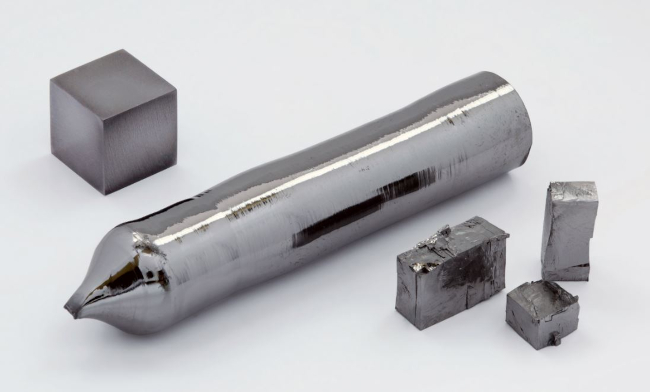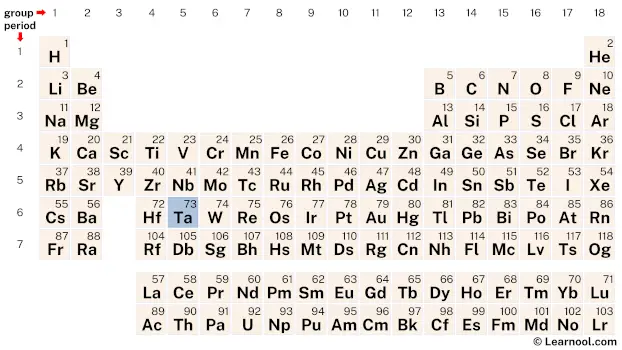
Tantalum (Ta) is a chemical element of the periodic table, located in the group 5 and the period 6, and has the atomic number 73. It is a hard, rare, shiny, silvery-grey transition metal, which is named after Tantalus, a Greek mythological character.
On periodic table
| group | ⇨ | 1 | 2 | 3 | 4 | 5 | 6 | 7 | 8 | 9 | 10 | 11 | 12 | 13 | 14 | 15 | 16 | 17 | 18 |
| period | ⇩ | ||||||||||||||||||
| 1 | 1 H  Hydrogen |
2 He  Helium |
|||||||||||||||||
| 2 | 3 Li  Lithium |
4 Be  Beryllium |
5 B  Boron |
6 C  Carbon |
7 N  Nitrogen |
8 O  Oxygen |
9 F  Fluorine |
10 Ne  Neon |
|||||||||||
| 3 | 11 Na  Sodium |
12 Mg  Magnesium |
13 Al  Aluminium |
14 Si Silicon |
15 P  Phosphorus |
16 S  Sulfur |
17 Cl  Chlorine |
18 Ar  Argon |
|||||||||||
| 4 | 19 K  Potassium |
20 Ca  Calcium |
21 Sc  Scandium |
22 Ti  Titanium |
23 V  Vanadium |
24 Cr  Chromium |
25 Mn  Manganese |
26 Fe  Iron |
27 Co  Cobalt |
28 Ni  Nickel |
29 Cu  Copper |
30 Zn  Zinc |
31 Ga  Gallium |
32 Ge  Germanium |
33 As  Arsenic |
34 Se  Selenium |
35 Br  Bromine |
36 Kr  Krypton |
|
| 5 | 37 Rb  Rubidium |
38 Sr  Strontium |
39 Y  Yttrium |
40 Zr  Zirconium |
41 Nb  Niobium |
42 Mo  Molybdenum |
43 Tc  Technetium |
44 Ru  Ruthenium |
45 Rh  Rhodium |
46 Pd  Palladium |
47 Ag  Silver |
48 Cd  Cadmium |
49 In  Indium |
50 Sn  Tin |
51 Sb  Antimony |
52 Te  Tellurium |
53 I  Iodine |
54 Xe  Xenon |
|
| 6 | 55 Cs  Caesium |
56 Ba  Barium |
72 Hf  Hafnium |
73 Ta Tantalum |
74 W  Tungsten |
75 Re  Rhenium |
76 Os  Osmium |
77 Ir  Iridium |
78 Pt  Platinum |
79 Au  Gold |
80 Hg  Mercury |
81 Tl  Thallium |
82 Pb  Lead |
83 Bi  Bismuth |
84 Po  Polonium |
85 At  Astatine |
86 Rn  Radon |
||
| 7 | 87 Fr  Francium |
88 Ra  Radium |
104 Rf  Rutherfordium |
105 Db  Dubnium |
106 Sg  Seaborgium |
107 Bh  Bohrium |
108 Hs  Hassium |
109 Mt  Meitnerium |
110 Ds  Darmstadtium |
111 Rg  Roentgenium |
112 Cn  Copernicium |
113 Nh  Nihonium |
114 Fl  Flerovium |
115 Mc  Moscovium |
116 Lv  Livermorium |
117 Ts  Tennessine |
118 Og  Oganesson |
||
| 57 La  Lanthanum |
58 Ce  Cerium |
59 Pr  Praseodymium |
60 Nd  Neodymium |
61 Pm  Promethium |
62 Sm  Samarium |
63 Eu  Europium |
64 Gd  Gadolinium |
65 Tb  Terbium |
66 Dy  Dysprosium |
67 Ho  Holmium |
68 Er  Erbium |
69 Tm  Thulium |
70 Yb  Ytterbium |
71 Lu  Lutetium |
|||||
| 89 Ac  Actinium |
90 Th  Thorium |
91 Pa  Protactinium |
92 U  Uranium |
93 Np  Neptunium |
94 Pu  Plutonium |
95 Am  Americium |
96 Cm  Curium |
97 Bk  Berkelium |
98 Cf  Californium |
99 Es  Einsteinium |
100 Fm  Fermium |
101 Md  Mendelevium |
102 No  Nobelium |
103 Lr  Lawrencium |
|||||
| – d block |
Tantalum is a d-block element, situated in the fifth column of the periodic table, between hafnium (Hf) and tungsten (W). It has the atomic number 73 and is denoted by the symbol Ta.
Element information
 |
|
 |
|
| Origin of name | named after Tantalus, a Greek mythological character |
| Symbol | Ta |
| Atomic number (Z) | 73 |
| Atomic mass | 180.94788 u |
| Block | d-block |
| Group | 5 |
| Period | 6 |
| Classification | Transition metal |
| Atomic radius | 146 pm |
| Covalent radius | 170±8 pm |
| Melting point | 3017 ℃, 5463 ℉, 3290 K |
| Boiling point | 5458 ℃, 9856 ℉, 5731 K |
| Electron configuration | [Xe] 4f14 5d3 6s2 |
| Learn how to write: Tantalum electron configuration | |
| Electrons per shell | 2, 8, 18, 32, 11, 2 |
| Learn how to draw: Tantalum Bohr model | |
| Crystal structure | Body-centered cubic (bcc) (α-Ta) Tetragonal (β-Ta) |
| Phase at r.t | Solid |
| Density near r.t | 16.69 g/cm3 |
| Main isotopes | Tantalum-180m, Tantalum-181 |
| Natural occurrence | Primordial |
| Oxidation state | +5 |
| Electronegativity (Pauling scale) | 1.5 |
| Protons Neutrons Electrons |
73 108 73 |
| Learn how to find: Tantalum protons neutrons electrons | |
| CAS number | 7440-25-7 |
| Discovered by | Andreas Gustaf Ekeberg in 1802 |
History

The element name comes from Tantalus, a character in Greek mythology. The history of tantalum dates back to the early 19th century when Swedish chemist Anders Gustaf Ekeberg discovered a new oxide mineral in a quarry in Ytterby, Sweden. He named the mineral tantalite after the Greek mythological character Tantalus, who was punished by the gods by being deprived of food and drink while standing in water up to his chin, because tantalum ores are often found in granite pegmatite ores that contain other rare elements.
Later in 1809, William Hyde Wollaston, an English chemist and physicist, extracted metallic tantalum by heating potassium tantalum fluoride with metallic potassium. However, it wasn’t until 1864 that Heinrich Rose, a German chemist, showed that tantalum was a distinct element, different from niobium. In 1903, Werner von Bolton, a German chemist, succeeded in reducing the tantalum chloride with sodium and thus obtained the pure metal.
During World War Ⅱ, tantalum was considered a strategic metal due to its importance in the manufacture of capacitors for radios and other electronic equipment. It was also used in the production of nuclear reactors and weapons. The demand for tantalum increased significantly during the Cold War, leading to exploration and development of tantalum mines in different parts of the world.
Occurrence and production
Tantalum is a rare, hard, and dense transition metal that is resistant to corrosion and has a high melting point. It is primarily found in the mineral columbite-tantalite, also known as coltan, which is mined in several countries including Australia, Brazil, and Canada.
Tantalum is typically extracted from its ores using a combination of gravity separation and electromagnetic separation techniques. The tantalum concentrate is then processed into a variety of forms, including powder, wire, and rod, through a series of chemical and physical processes such as reduction, distillation, and electron-beam melting.
Because tantalum is relatively rare and difficult to extract, its production is limited. The majority of tantalum is used in the electronics industry for capacitors and high-performance electronic components.
Properties
Tantalum is a rare, hard, blue-gray, lustrous transition metal that is highly corrosion-resistant.
It has a melting point of 3017 ℃ and a boiling point of 5458 ℃.
Tantalum is a dense metal, with a density of 16.69 g/cm3.
It is not soluble in most acids, except hydrofluoric acid, and has a high electrical conductivity.
Tantalum is a relatively stable metal, forming a protective oxide layer when exposed to air that makes it resistant to corrosion.
It has a high melting point, making it useful in high-temperature applications such as furnace parts and heating elements.
Tantalum is also used in the production of capacitors, as tantalum capacitors have a high capacitance per volume and low leakage current.
Tantalum can be alloyed with other metals to improve their properties, such as tungsten for increased hardness and resistance to wear, or titanium for improved strength and corrosion resistance.
Applications
Tantalum is widely used in electronics due to its high capacitance, stability, and ability to withstand high temperatures. It is used in capacitors, resistors, and other electronic components.
Tantalum is used in the aerospace and defense industries due to its high melting point, strength, and corrosion resistance. It is used in rocket nozzles, turbine blades, and other components.
Tantalum is biocompatible and corrosion-resistant, making it ideal for use in medical implants such as dental implants, bone plates, and pacemaker electrodes.
Tantalum’s resistance to corrosion makes it a valuable material for chemical processing equipment, such as heat exchangers and reactors.
Tantalum is used in jewelry due to its attractive color and durability. It is often used as a substitute for platinum.
Tantalum is used in superconducting materials, such as tantalum nitride, which has potential applications in electronics and quantum computing.
Interesting facts
Tantalum was named after the Greek mythological character Tantalus.
It is a rare element, constituting only about 0.0002% of the Earth’s crust.
Tantalum is highly resistant to corrosion and is used in surgical implants due to its biocompatibility with human tissue.
Tantalum has a high melting point of 3017 ℃, making it useful for high-temperature applications such as jet engine components.
Tantalum is commonly used in capacitors for electronic devices due to its ability to hold a high electric charge and low leakage current.
The most common ore of tantalum is columbite-tantalite, also known as coltan, which is often mined in conflict zones in Africa and has led to ethical concerns about the supply chain.
Related
More elements
External links
- https://www.rsc.org/periodic-table/element/73/tantalum
- https://en.wikipedia.org/wiki/Tantalum
- https://www.britannica.com/science/tantalum
- https://education.jlab.org/itselemental/ele073.html
- https://www.chemicool.com/elements/tantalum.html
- https://pubchem.ncbi.nlm.nih.gov/element/Tantalum
- https://www.livescience.com/38994-facts-about-tantalum.html
- https://www.radiochemistry.org/periodictable/elements/73.html
- https://www.thoughtco.com/tantalum-facts-606600
Deep
Learnool.com was founded by Deep Rana, who is a mechanical engineer by profession and a blogger by passion. He has a good conceptual knowledge on different educational topics and he provides the same on this website. He loves to learn something new everyday and believes that the best utilization of free time is developing a new skill.
